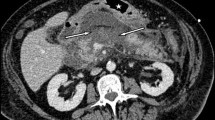Abstract
Background
Traditional approach for surgical management of mature pancreatic pseudocysts is by internal surgical drainage. Endoscopic drainage procedures have also been described. We describe Natural Orifice Translumenal Endoscopic Surgery (NOTES®) stapled cystgastrostomy as a less invasive surgical procedure.
Study design
Case series.
Methods
NOTES® cystgastrostomy was performed in six patients with mature pseudocysts from June 2007 to July 2009 under institutional review board (IRB) protocol. The size of the pseudocysts varied from 8 to 23 cm, and all of the pseudocysts were considered complex pseudocysts. The operative team included two general surgeons and a gastroenterologist. The procedure included endoscopic ultrasound (EUS)-guided puncture of the stomach just below the gastroesophageal (GE) junction to gain access to the pseudocyst, guidewire placement, and then dilatation with a balloon to 18–20 mm. Endoscopic necrosectomy and debridement were performed when possible, followed by transoral surgical anastomosis under endoscopic visualization with the SurgAssist™ SLC 55 (Power Medical Interventions, Langhorne, PA) 4.8-mm stapler. Anastomotic length varied from 5.5 to 8 cm. In one patient, diagnostic laparoscopy was performed after the procedure due to inadvertent pneumoperitoneum; no leak or perforation was identified.
Results
Length of stay varied between 2 and 14 days. All patients had routine esophagogastroduodenoscopy (EGD) at 1 and 6 weeks postoperatively to evaluate patency; computed tomography (CT) scan was done at 2–3 months to demonstrate resolution of the pseudocyst. All patients had significant decrease in pseudocyst size with patent anastomosis on postoperative EGD, although one patient required endoscopic anastomotic dilatation due to continued symptoms 6 weeks after the operation. Her pseudocyst completely resolved 4 months postoperatively. An additional patient required subsequent distal pancreatectomy due to recurrent symptoms of chronic pancreatitis.
Conclusion
NOTES® cystgastrostomy is comparable to previously described surgical approaches, yet is as minimally invasive as endoscopic drainage procedures previously described for management of pseudocysts. It is less invasive than laparoscopic or open cystgastrostomy, yet provides definitive treatment.






Similar content being viewed by others
References
Rao GV, Reddy DN (2005) Transgastric appendectomy. Video Presentation, Society of Gastrointestinal Endoscopic Surgeons Annual Meeting, April 2005, Ft. Lauderdale, FL
Bessler M, Stevens PD, Milone L, Parikh M, Fowler D (2007) Transvaginal laparoscopically assisted endoscopic cholecystectomy: a hybrid approach to natural orifice surgery. Gastrointest Endosc 66:1243–1245
Gumbs AA, Fowler D, Milone L, Evanko JC, Ude AO, Stevens P, Bessler M (2009) Transvaginal natural orifice translumenal endoscopic surgery cholecystectomy: early evolution of the technique. Ann Surg 249(6):908–912
Romanelli JR, Desilets DJ, Earle DB (2008) Pancreatic pseudocystgastrostomy with a peroral flexible stapler: human natural orifice translumenal endoscopic surgery anastomosis in 2 patients. Gastrointest Endosc 68(5):981–987
Bradley EL (1993) A clinically based classification system for acute pancreatitis: summary of the international symposium on Acute Pancreatitis. Arch Surg 128:586–590
Kozarek RA, Brayko CM, Harlan J, Sanowski RA, Cintora I, Kovac A (1985) Endoscopic drainage of pancreatic pseudocysts. Gastrointest Endosc 31:322–328
Brandenburg F, Maddock S, Schweitzer R (1951) Cystgastrostomy. A treatment of pancreatic pseudocysts. Ann Surg 133(2):219–225
Taghizadeh F, Bowler RJ, Kiesewetter WB (1979) Stapled cystgastrostomy. A method of treatment of pediatric pancreatic pseudocyst. Ann Surg 137:134–141
Trias M, Targarona EM, Balagué C, Cifuentes A, Taurá P (1995) Intraluminal stapled laparoscopic cystgastrostomy for treatment of pancreatic pseudocyst. Br J Surg 82:403
Kähler GF, Langner C, Suchan KL, Freudenberg S, Post S (2006) Endoscopic full-thickness resection of the stomach: an experimental approach. Surg Endosc 20(3):519–521. Epub 2006 Jan 25
Evans JA, Rosato FE, Ginsberg GG (2007) Gastrostomy port assisted full-thickness gastric resection by using the peroral SurgASSIST™ introduced via an oroesophageal overtube in a porcine model. Gastrointest Endosc 65(4):684–687
Kähler G, Grobholz R, Langner C, Suchan K, Post S (2006) A new technique of endoscopic full-thickness resection using a flexible stapler. Endoscopy 38(1):86–89
Wadhwa A, Chowbey PK, Sharma A, Khullar R, Soni V, Baijal M (2003) Combined procedures in laparoscopic surgery. Surg Laparosc Endosc Percutan Tech 13(6):382–386
Melman L, Azar R, Beddow K, Brunt LM, Halpin VJ, Eagon JC, Frisella MM, Edmundowicz S, Jonnalagadda S, Matthews BD (2009) Primary and overall success rates for clinical outcomes after laparoscopic, endoscopic and open pancreatic cystgastrostomy for pancreatic pseudocysts. Surg Endosc 23:267–271
Baron TH, Harewood GC, Morgan DE, Yates MR (2002) Outcome differences after endoscopic drainage of pancreatic necrosis, acute pancreatic pseudocysts, and chronic pancreatic pseudocysts. Gastrointest Endosc 56(1):7–17
Hookey LC, Debroux S, Delhaye M, Arvanitakis M, Le Moine O, Devière J (2006) Endoscopic drainage of pancreatic-fluid collections in 116 patients: a comparison of etiologies, drainage techniques, and outcomes. Gastrointest Endosc 63(4):635–643
Disclosures
Author Ratnakishore Pallapothu has nothing to disclose. Author David B. Earle has the following disclosures: SurgiQuest, Inc.—Consultant and Scientific Advisory Board; Covidien, Inc.—Fellowship Grant Support; Atrium Medical Corporation—Consultant. Author David J. Desilets has the following disclosure: Wilson-Cook, Inc.—Grant Support. Author John R. Romanelli has the following disclosures: SurgiQuest, Inc.—Consultant; Power Medical Interventions—Consultant and Research Support.
Author information
Authors and Affiliations
Corresponding author
Rights and permissions
About this article
Cite this article
Pallapothu, R., Earle, D.B., Desilets, D.J. et al. NOTES® stapled cystgastrostomy: a novel approach for surgical management of pancreatic pseudocysts. Surg Endosc 25, 883–889 (2011). https://doi.org/10.1007/s00464-010-1289-2
Received:
Accepted:
Published:
Issue Date:
DOI: https://doi.org/10.1007/s00464-010-1289-2




